Kopnin N.B. Theory of Nonequilibrium Superconductivity
Подождите немного. Документ загружается.

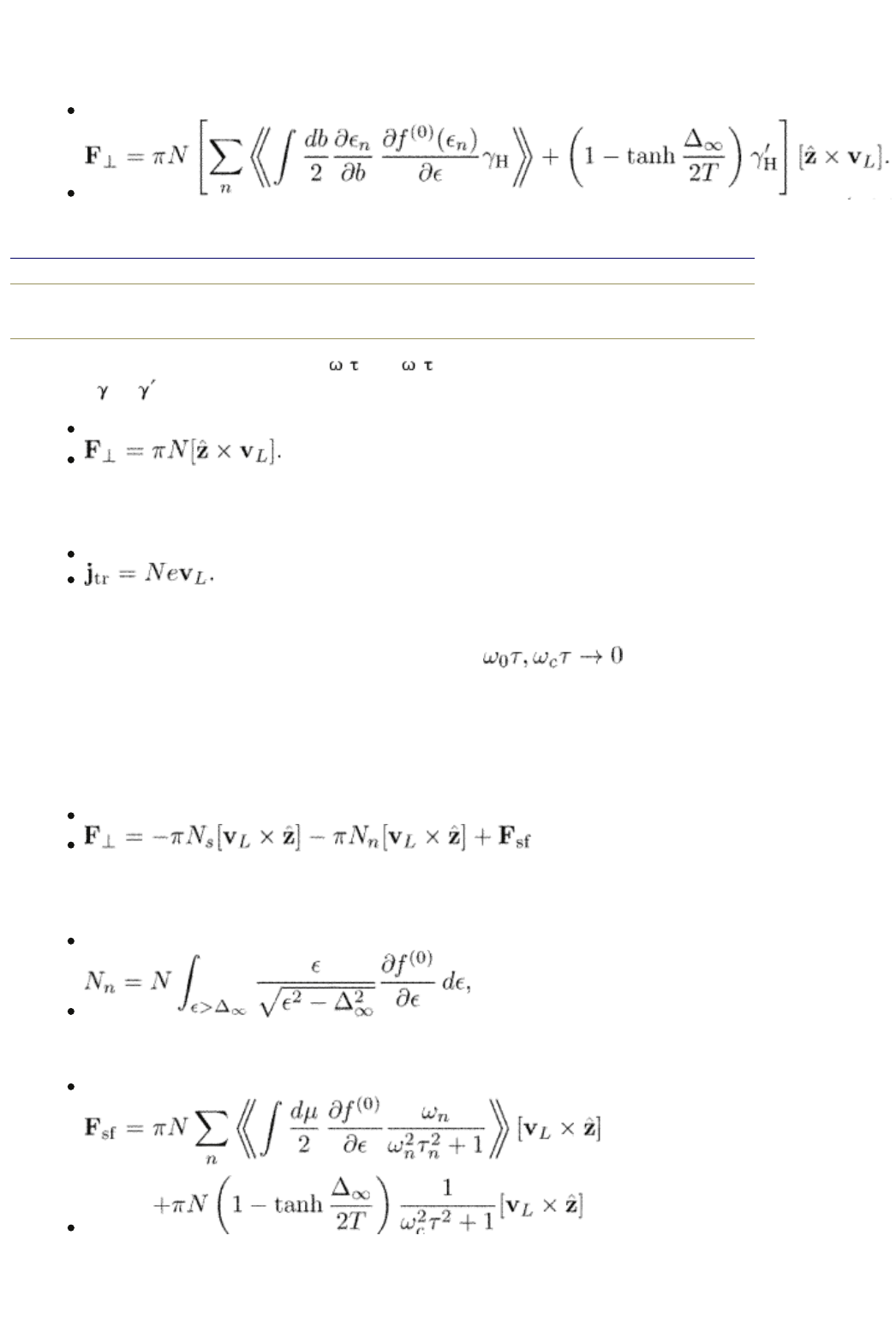
more detailed discussion because it has been a matter of controversy for a long
time since first calculated for vortices in helium II by Lifshitz and Pitaevskii
(1957) and then by Iordanskii (1964). Consider for simplicity a spherical Fermi
surface. The full transverse force from eqns (14.64) and (14.65) is
(14.88)
end p.298
In the superclean limit, when both
c
and
0
are much larger than unity, the
factors
H =
H
= 1, and the transverse force becomes (see page 276)
(14.89)
The balance eqn (14.7) against the Lorentz force gives the transport current in
the form
(14.90)
This equation is consistent with the Helmholtz theorem of conservation of
circulation, in an ideal fluid: vortices move together with the flow. On the
contrary, the transverse force disappears in the limit
. This is
the overall behavior of the transverse force as a function of the quasiparticle
mean free path.
From the historical point of view it is interesting to identify several contribution
to the transverse force and consider them one by one. We can present the full
transverse force in the form
(14.91)
where N
n
is the density of normal quasiparticles at large distances from the
vortex core
(14.92)
while superconduting density is N
s
= N – N
n
. The force
(14.93)
is called the spectral flow force (Kopnin et al. 1995).
Let us consider now the transport current that enters the force balance equation
PRINTED FROM OXFORD SCHOLARSHIP ONLINE (www.oxfordscholarship.com)
© Copyright Oxford University Press, 2003-2010. All Rights Reserved
Oxford Scholarship Online: Theory of Nonequilibrium Supe... http://www.oxfordscholarship.com/oso/private/content/phy...
第4页 共6页 2010-8-8 16:10

through the Lorentz force. In presence of an electric field,
the transport current is not entirely due to a supercurrent, a part of it being
carried by delocalized quasiparticles. Far from the vortex core, the quasiparticle
(normal) current is
(14.94)
Using eqns (14.9) and (14.54) we find
(14.95)
Writing the transport current as j
tr
= N
s
ev
s
+ j
(qp)
we get the force balance eqn
(14.4) in the form
end p.299
(14.96)
Here
is the Magnus force;
(14.97)
is the Lorentz force from the quasiparticle current eqn (14.95). The force
is called the Iordanskii force (Iordanskii 1964). The Iordanskii force is the
counterpart of the Magnus force for normal excitations. We have included the
normal velocity v
n
to make this similarity more transparent. In our consideration,
the normal velocity is always zero v
n
= 0 since the equilibrium corresponds to
excitations at rest in the reference frame associated with the crystal lattice.
The spectral flow force F
sf
is mostly due to the momentum flow from the Fermi
sea of normal excitations to the moving vortex via the gapless spectral branch
(the term n = 0 in the sum) going through the vortex core from negative to
positive energies (Volovik 1986, Stone and Gaitan 1987). Due to the
time-dependent angular momentum of the excitations
, there appears a flow (with the velocity
/ t) of spectral levels characterized by the angular momentum . Each particle
on a level carries a momentum p
F
. The momentum transfer to the vortex is
effective if the quasiparticle relaxation occurs quickly: the factor
in the first line of eqn (14.93) accounts for the relaxation on localized levels: the
relaxation and hence the momentum transfer is complete for
, and
vanishes in the opposite limit. The first term in eqn (14.93) thus describes a
disorder-mediated momentum flow along the anomalous chiral branch
0
( ) for
PRINTED FROM OXFORD SCHOLARSHIP ONLINE (www.oxfordscholarship.com)
© Copyright Oxford University Press, 2003-2010. All Rights Reserved
Oxford Scholarship Online: Theory of Nonequilibrium Supe... http://www.oxfordscholarship.com/oso/private/content/phy...
第5页 共6页 2010-8-8 16:10
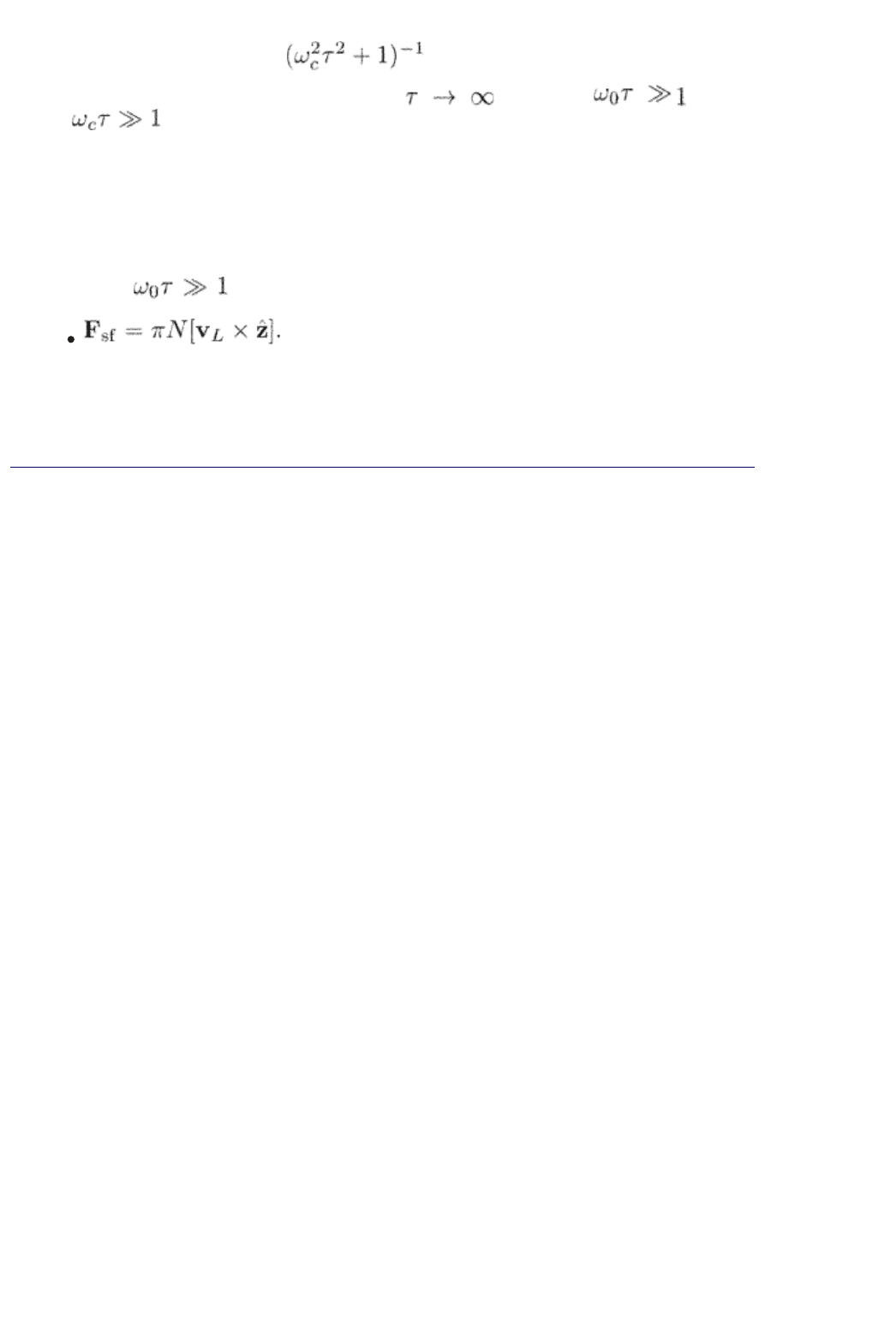
energies below the gap. The second line in eqn (14.93) accounts for the spectral
flow for energies above the gap. The corresponding factor which takes into
account the relaxation rate is
.
The spectral flow force vanishes in the limit
when both
and such that the transverse force is given by eqn (14.89). The
quasiparticle current is j(
qp
) = N
n
ev
L
so that the force from the quasiparticle
current compensates the Iordanskii force. The force balance eqn (14.96) reduces
to F
M
= 0. The vortex thus moves with the superfluid velocity v
L
= v
s
. As follows
from eqn (14.56), quasiparticles also have a velocity v
L
so that all the particles
move together which amounts to the total current as in eqn (14.90).
On the contrary, the spectral flow force has its maximum value for moderately
clean limit,
. Equation (14.93) gives in this limit
This completely compensates the first two terms in eqn (14.91), i.e, the
Iordanskii force and the part of the Magnus force that contains the vortex
velocity; the
end p.300
Top
Privacy Policy and Legal Notice © Oxford University Press, 2003-2010. All rights reserved.
Oxford Scholarship Online: Theory of Nonequilibrium Supe... http://www.oxfordscholarship.com/oso/private/content/phy...
第6页 共6页 2010-8-8 16:10
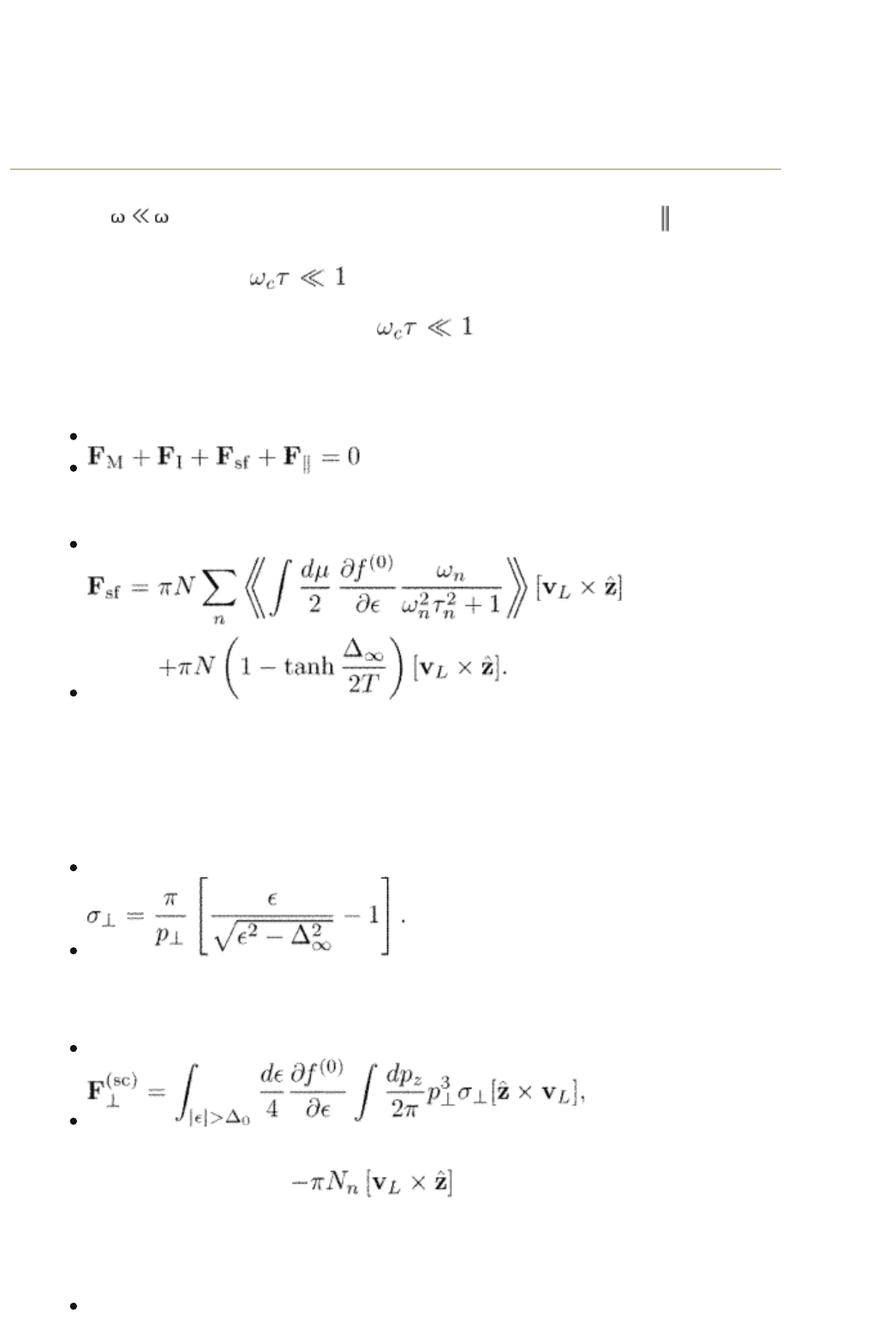
transverse force vanishes. The quasiparticle current vanishes even faster
because
c
0
. The Lorentz force is balanced only by a friction force F . As a
result, the dissipative dynamics is restored.
The low-field limit when
is most practical for superconductors.
Moreover, this regime is realized in electrically neutral superfluids such as
3
He.
As we already know, the low field limit
corresponds to a situation
when the delocalized excitations are at rest with the heat bath. Since delocalized
excitations are in equilibrium the quasiparticle current vanishes. The force
balance becomes
(14.98)
where the spectral flow force is
(14.99)
It is interesting to note that the spectral flow force from above gap states in this
case is related to the anomalous contribution to the transverse vortex cross
section for scattering of delocalized quasiparticles. The transverse vortex cross
section was calculated by Kopnin and Kravtsov (1976 b) and by Galperin and
Sonin (1976):
(14.100)
Inserting eqn (14.100) into the expression for the force exerted on the vortex by
scattered excitations,
(14.101)
we recover the last two terms in eqn (14.91) that are due to the normal
excitations, namely the term and the last term in the spectral
flow force eqn (14.99).
The first term in eqn (14.100) corresponds to the cross section of a vortex in a
Bose superfluid (Sonin 1987)
(14.102)
Kopnin, Nikolai, Senior Scientist, Low Temperature Laboratory, Helsinki University of
Technology, and L.D. Landau Institute for Theoretical Physics, Moscow
Theory of Nonequilibrium Superconductivity
Print ISBN 9780198507888, 2001
pp. [301]-[305]
Oxford Scholarship Online: Theory of Nonequilibrium Supe... http://www.oxfordscholarship.com/oso/private/content/phy...
第1页 共5页 2010-8-8 16:11
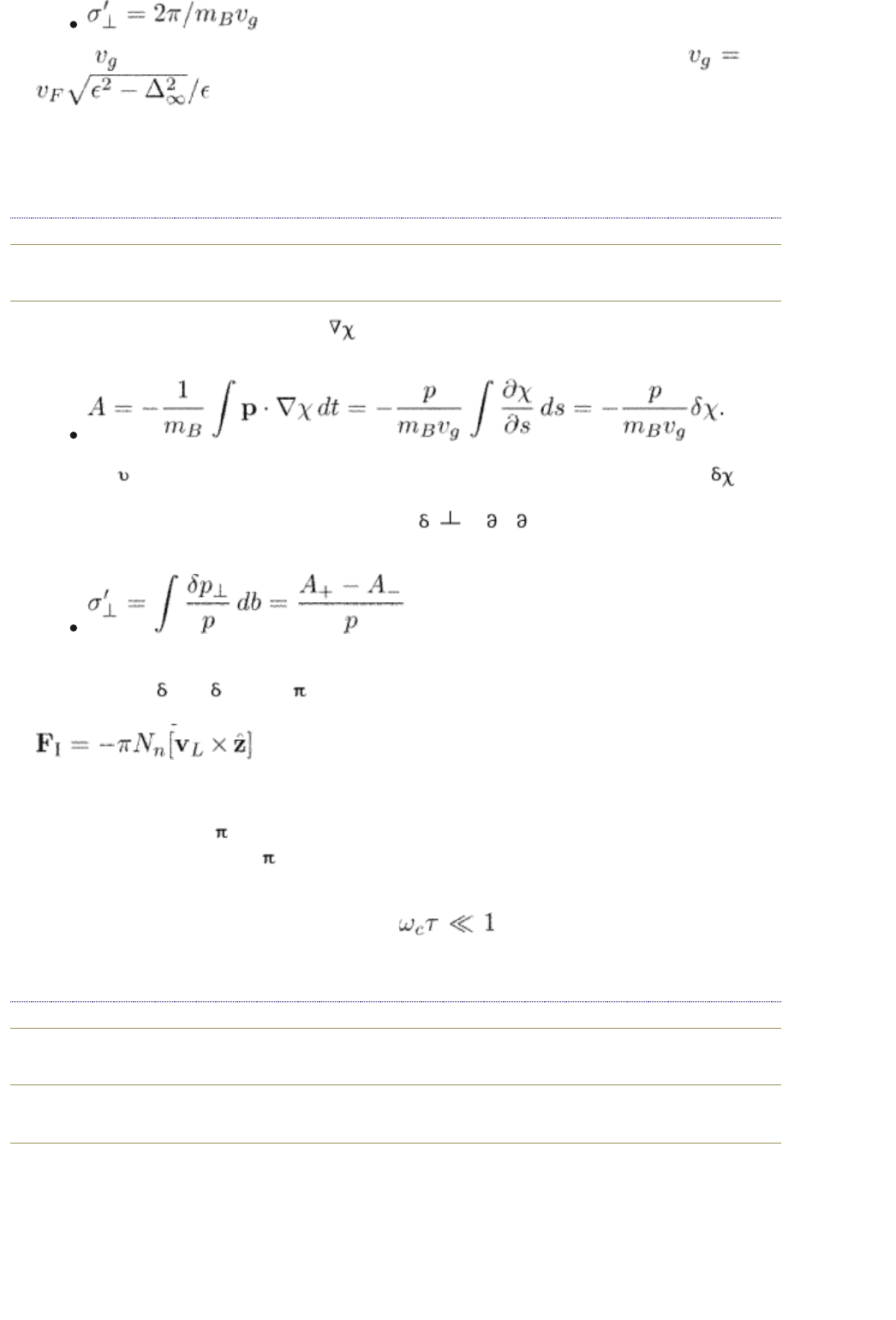
where is the group velocity defined by eqn (1.88) which, in our case, is
, and m
B
is the mass of a Bosonic atom. Note that, in our
case. m
B
= 2m. The corresponding part of the transverse cross section can be
easily obtained from the semi-classical description. Indeed, the Doppler energy
due to
end p.301
the vortex velocity is P · v
s
= P · /m
B
. Its contribution to the quasiparticle
action is
Hero s =
g
t is the coordinate along the particle trajectory as in Fig. 6.1. and
is the variation of the order parameter phase along the trajectory. The change in
the transverse momentum of the particle is
p = A/ b hence the transverse
cross section becomes
where A
±
is the action along the trajectory passing on the left (right) side of the
vortex. Since
x
+
– x
–
= – 2 we recover eqn (14.102). With this expression
for the cross section, eqn (14.101) gives the Iordanskii force
.
The second term in eqn (14.100) originates from the fact that here, as distinct
from the situation in a Bose superfluid, the phase of the single-particle wave
function changes by
upon encircling the vortex, while it is the order parameter
phase which changes by 2
. It is this singularity, produced by the vortex in the
single-particle wave function, which results in the anomalous contribution to the
cross section in eqn (14.100). Inserted into eqn (14.101). it exactly reproduces
the second term in eqn (14.93) taken for
. We see that the spectral
flow force is related to a single-particle anomaly associated with the vortex.
end p.302
15 BOLIZMANN KINETIC EQUATION
Nikolai B. Kopnin
Abstract: This chapter derives the canonical Boltzmann kinetic equation for two
particular examples. First case is a superconductor with homogeneous in space
order-parameter magnitude and current. The second example treats the
excitations in the vortex core. The Boltzmann equation is then applied to
calculate the vortex momentum and vortex mass. It is also used for the vortex
PRINTED FROM OXFORD SCHOLARSHIP ONLINE (www.oxfordscholarship.com)
© Copyright Oxford University Press, 2003-2010. All Rights Reserved
PRINTED FROM OXFORD SCHOLARSHIP ONLINE (www.oxfordscholarship.com)
© Copyright Oxford University Press, 2003-2010. All Rights Reserved
Oxford Scholarship Online: Theory of Nonequilibrium Supe... http://www.oxfordscholarship.com/oso/private/content/phy...
第2页 共5页 2010-8-8 16:11
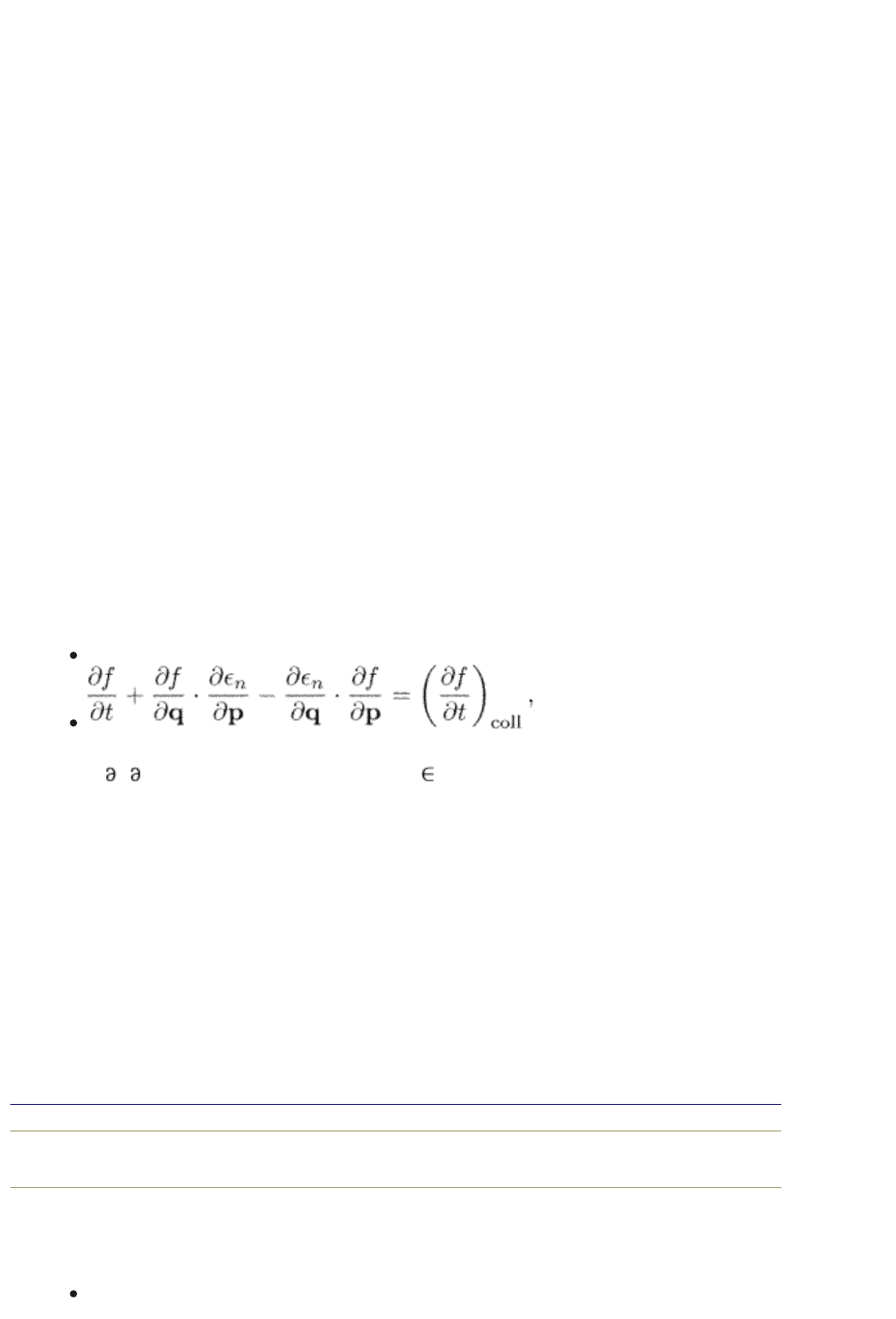
dynamics in a d-wave superconductor. The non-trivial behaviour of the d-wave
flux-flow conductivity and the Hall effect is discussed.
Keywords: kinetic equation, vortex momentum, vortex mass, d-wave
superconductor, flux-flow conductivity, Hall effect
We derive the canonical Boltzmann kinetic equation for two particular
examples. First case is a superconductor with homogeneous in space
order-parameter magnitude and current. The second example treats the
excitations in the vortex core. The Boltzmann equation is applied to
calculate the vortex mass and to study the vortex dynamics in a d-wave
superconductor.
15.1 Canonical equations
The microscopic nonstationary theory of superconductivity based on the Green
function technique is a powerful method to describe the vortex dynamics both in
dirty and in clean superconductors, as well as in other superfluid Fermi systems.
However, a practical disadvantage of the method is its mathematical complexity,
which tends to hide the physical picture of the phenomenon. For a clean system,
where the excitation spectrum is well defined, an alternative way to deal with
dynamical processes is expected to be based on the quasiclassical Boltzmann
kinetic equation. For normal metals, the equivalence of the quasiclassical Green
function approach to the Boltzmann equation has been demonstrated by Keldysh
(1964). In Chapter 10 we have derived the set of kinetic equations which are
suitable for many nonstationary problems in the theory of superconductivity. In
the present chapter we consider a few examples for which the generalized kinetic
equations can be reduced to the canonical Boltzmann form
(15.1)
Where ( f/ t)
coll
is the collision integral and
n
(q, p) is the quasiclassical
excitation spectrum, characterized by the canonically conjugated generalized
“coordinate” q and. “momentum” p of the excitation (n denotes the set of other
quantum numbers). The first example is the case of constant in space order
parameter and supercurrent. We shall see that the Boltzmann equation is in this
case completely similar to its normal-metal counterpart. Other examples refer to
the dynamics of excitations in the presence of moving vortices.
15.2 Uniform order parameter
One can easily derive the canonical form of the Boltzmann equation for a
situation where the order parameter magnitude, supercurrent, and external
fields only
end p.303
slowly vary in space and in time (Betbeder-Matibet and Nozières 1969, Aronov et
al. 1981, 1986). We have already discussed this equation in Section 1.2.3. Let us
define the energy of excitations as in eqn (1.54)
(15.2)
PRINTED FROM OXFORD SCHOLARSHIP ONLINE (www.oxfordscholarship.com)
© Copyright Oxford University Press, 2003-2010. All Rights Reserved
Oxford Scholarship Online: Theory of Nonequilibrium Supe... http://www.oxfordscholarship.com/oso/private/content/phy...
第3页 共5页 2010-8-8 16:11
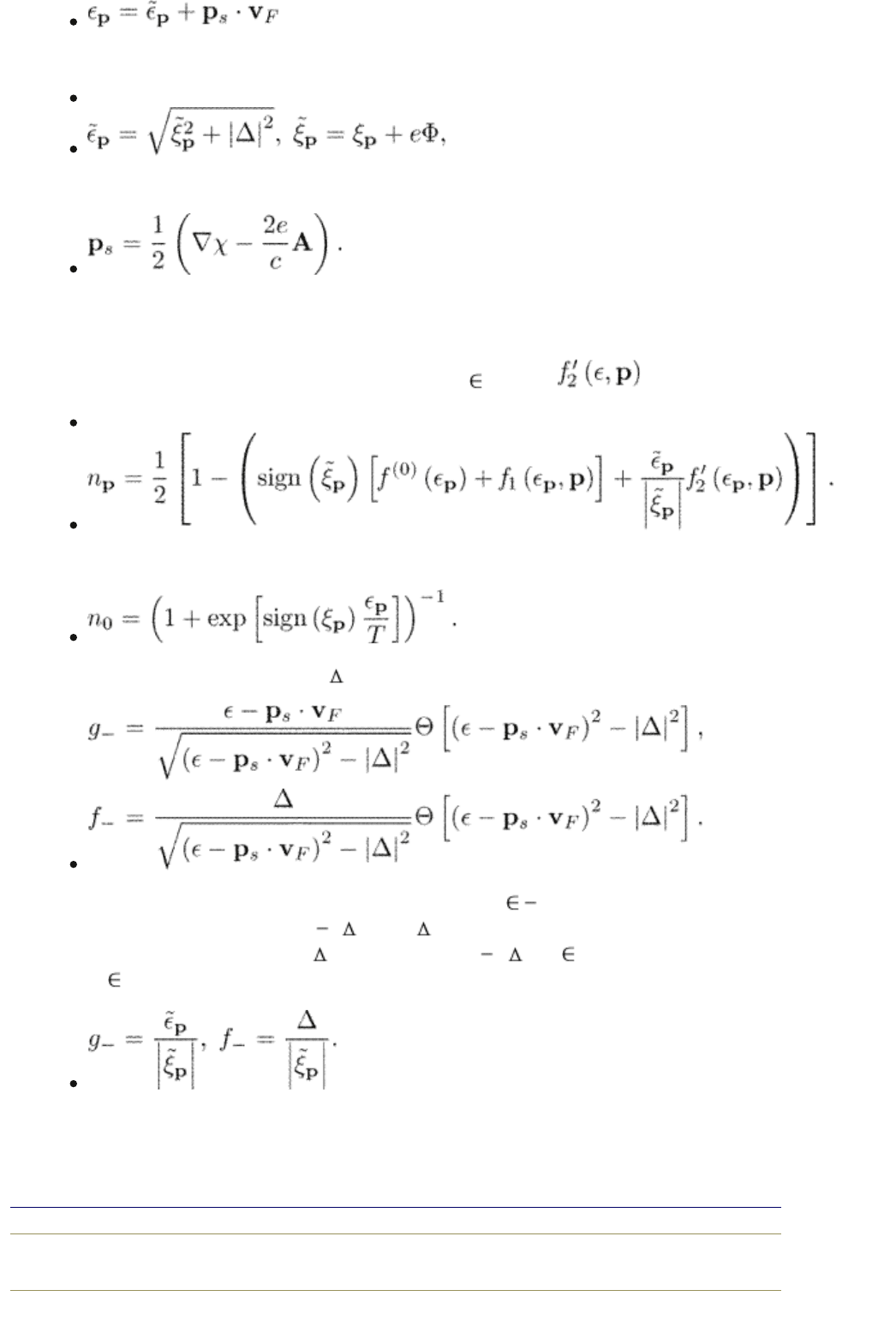
where
(15.3)
and
According to the definition eqn (15.2), the excitation energy is always positive.
This coincides with the Landau picture of the Fermi liquid. We define the
distribution function for the excitations with the energy spectrum eqn (15.2)
through our generalized distribution functions f
1
( , p) and as
(15.4)
In equilibrium, it is the Fermi function
We also note that for a constant | | and p
s
, the Green functions are
The radicals are defined as analytical functions of x = p
s
· v
F
on the complex
plane of x with the cut between
| | and | | (see Fig. 5.1); they change sign
when x goes from positive x > |
| to negative x < | |. If is replaced with a
positive
p
, the Green functions become
One can check after some algebra that in the linear approximation with respect
to the deviation from equilibrium, the two equations (10.52) and (10.53)
end p.304
PRINTED FROM OXFORD SCHOLARSHIP ONLINE (www.oxfordscholarship.com)
© Copyright Oxford University Press, 2003-2010. All Rights Reserved
Oxford Scholarship Online: Theory of Nonequilibrium Supe... http://www.oxfordscholarship.com/oso/private/content/phy...
第4页 共5页 2010-8-8 16:11
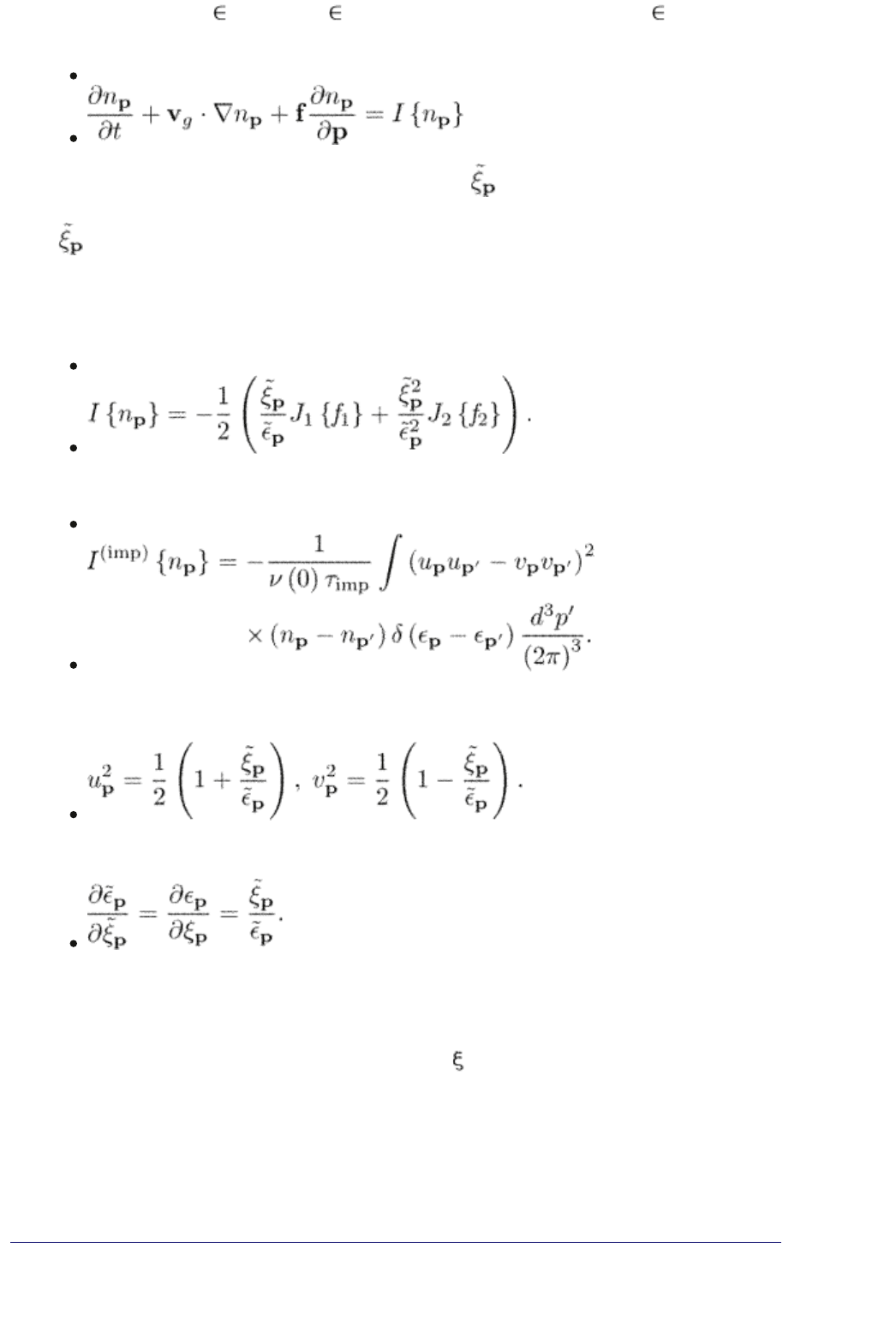
for the functions f
1
( , p) and f
2
( , p) possessing a definite parity in ( , p) can
be written as one equation
(15.5)
for the function n
p
which has no definite parity in . Equations (10.52) and
(10.53) can be recovered from eqn (15.5) by separating the even and odd parts
in
. The group velocity v
g
and the elementary force f including the Lorentz
force are defined in eqn (1.88). Equation (15.5) coincides with eqn (1.87) used in
the beginning of this book.
The collision integral in eqn (15.5) has the form
(15.6)
For example, the impurity collision integral becomes
(15.7)
The Bogoliubov–de Gennes coherence factors are as in eqn (1.56)
During the transformation we use the relation
Equation (15.5) has the form of the canonical Boltzmann equation. However, its
region of applicability is limited to the situation where the order parameter and
the supercurrent are almost uniform in space. One would think that the required
scale of spatial variations should be larger than
. However, this condition does
not guarantee that the obtained results are correct. The point is that the spatial
variations also result in distortions of the quasiparticle spectrum. These
distortions are not included into eqns (15.2), (15.3) though they can be
important for some of the responses. We consider now one such example when
the distortion of the spectrum provided by eqns (14.31) and (14.32) is important
for calculating the flux flow conductivity.
end p.305
Top
Privacy Policy and Legal Notice © Oxford University Press, 2003-2010. All rights reserved.
Oxford Scholarship Online: Theory of Nonequilibrium Supe... http://www.oxfordscholarship.com/oso/private/content/phy...
第5页 共5页 2010-8-8 16:11
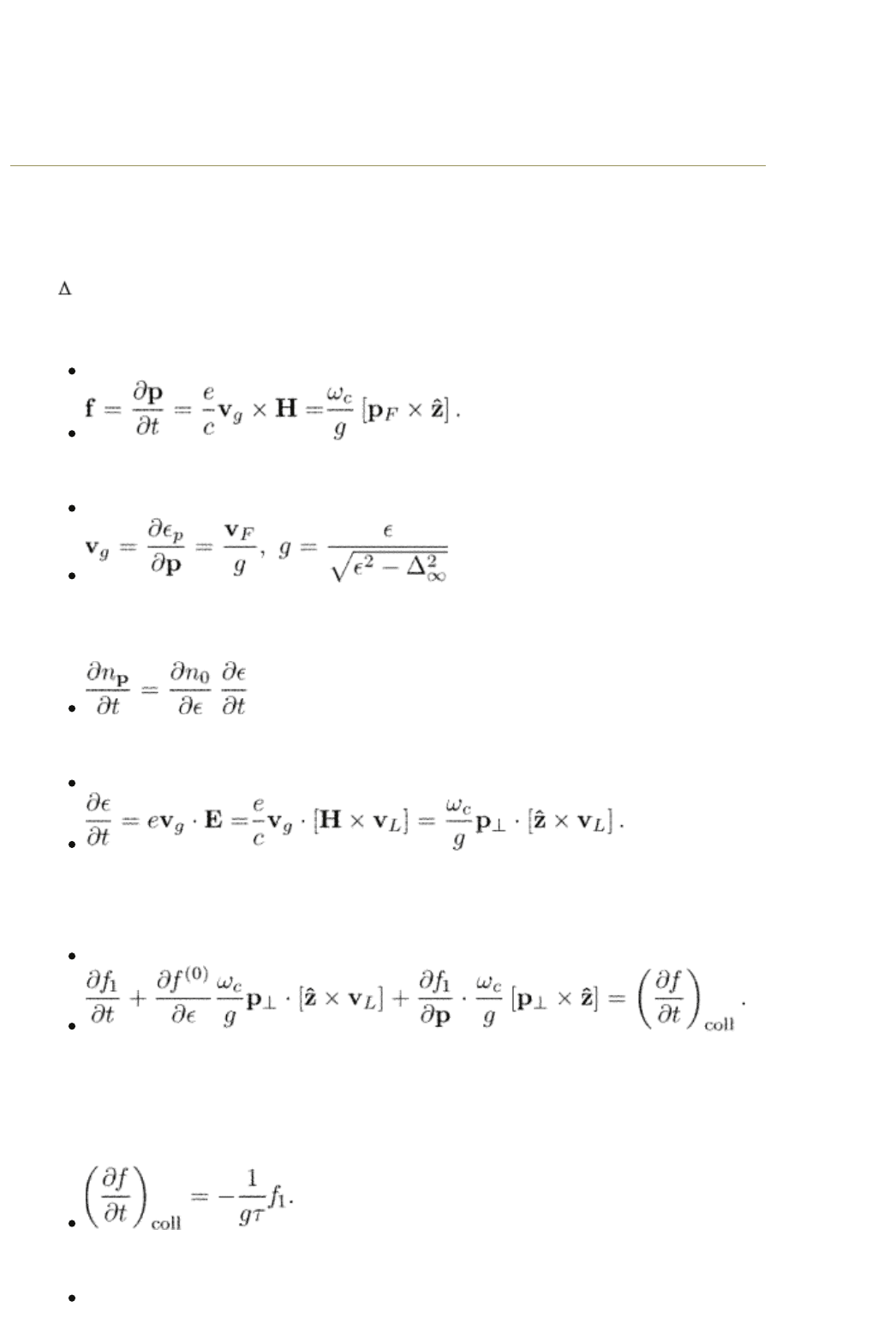
15.2.1 Boltzmann equation in presence of vortices
A delocalized particle moves mostly far from the vortex core where the order
parameter is constant and the superfluid velocity potential pv
s
is small compared
to
. One could thus expect that the kinetic equation for delocalized excitations
has its conventional form eqn (15.5) derived above. However, this is not exactly
the case. To see this let us put the elementary Lorentz force in eqn (15.5) to be
(15.8)
This expression contains the group velocity
(15.9)
in contrast to the previous definition eqn (1.88) that simply has v
F
. The driving
term is also written in a slightly different way. We put
where the time-derivative of energy
(15.10)
now also contains the group velocity instead of v
F
as in eqn (1.90).
The kinetic equation for the function f
1
becomes
(15.11)
The spatial derivative of the distribution function vanishes since f
1
is constant in
space.
For the energy spectrum of eqns (15.2, 15.3) the collision integral eqn (15.6)
reduces to
Finally, the kinetic equation (15.11) for a steady distribution takes the form
(15.12)
Kopnin, Nikolai, Senior Scientist, Low Temperature Laboratory, Helsinki University of
Technology, and L.D. Landau Institute for Theoretical Physics, Moscow
Theory of Nonequilibrium Superconductivity
Print ISBN 9780198507888, 2001
pp. [306]-[310]
Oxford Scholarship Online: Theory of Nonequilibrium Supe... http://www.oxfordscholarship.com/oso/private/content/phy...
第1页 共6页 2010-8-8 16:11

which coincides with the microscopic equation (14.53). Its solution provides the
distribution function in the form of eqn (14.51) with the factors
determined
by eqn (14.54).
end p.306
It is thus eqn (15.11) that should be used for quasiparticles traveling through the
vortex array rather than eqn (15.5) derived assuming a constant order
parameter and uniform supercurrents. The correct equation contains the group
velocity rather than v
F
in the elementary force eqn (15.9) and in the energy gain
eqn (15.10). Looking back at the derivation of eqn (14.53) we observe that if we
had omitted the gradient terms from
in eqn (14.52) we would only have
(e/c)[v
F
× H]g left in [see eqn (13.11)] and would thus obtain an extra
factor g
both in eqn (15.10) and in front of the elementary Lorentz force. The
compensating contribution comes from the gradient expansion eqns (14.31,
14.32) through the identity eqn (14.34).
15.3 Quasiparticles in the vortex core
Consider another example of application of the Boltzmann equation to the vortex
dynamics in clean superconductors. We study kinetic of excitations localized in
the vortex cores (Stone 1996, Kopnin and Volovik 1997). We start with an
observation that eqn (14.42) which we derived from kinetic equations (14.35)
and (14.36) already looks almost like the canonical equation (15.1). In this
section we present a microscopic verification of (15.1) for a genera case (Blatter
et al. 1999) when
can depend on the quasiparticle momentum as it is the case,
for example, in d-wave superconductors. We demonstrate that our kinetic
equations for the generalized distribution function derived from the quasiclassical
Green function formalism can be further transformed into the simple and
physically transparent canonical equation (15.1). We restrict ourselves to the
particular example of vortex dynamics; the calculation can be generalized to
include the dynamics of other topological defects in superfluid Fermi systems.
In Section 14.5, we have derived microscopically the force acting on a moving
vortex, eqn (14.62). This equation shows that, within the quasiclassical
approximation, the force F
env
can be represented as the momentum transfer from
the heat bath via the localized quasiparticle excitations to the vortex [compare
with equ (14.4)],
(15.13)
where p
n
/ t =
n
(q, p)/ q and d is the dimensionality of the problem (d = 1
in case of vortices). Our analysis thus provides a microscopic verification of the
phenomenological approach to the vortex dynamics based on the concept of
semiclassical particles obeying the Boltzmann kinetic equation where the
quasiclassical spectrum
n
of excitations in the vortex core plays the role of the
Hamiltonian, and the force acting on the vortex results from the elementary
force
p
n
/ t the quasiparticles exert on the vortex core. Later in this chapter, we
PRINTED FROM OXFORD SCHOLARSHIP ONLINE (www.oxfordscholarship.com)
© Copyright Oxford University Press, 2003-2010. All Rights Reserved
Oxford Scholarship Online: Theory of Nonequilibrium Supe... http://www.oxfordscholarship.com/oso/private/content/phy...
第2页 共6页 2010-8-8 16:11
